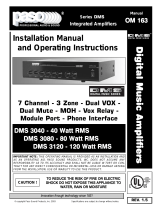6
14. Ground terminal
A functional ground terminal.
15. DC input terminals
Connect to a 24 V DC power supply.
16. Output terminals
Connect to speakers. Output signals from the
ZONE 1 and 2 output terminals when the front-
mounted ZONE 1 and 2 switches (8) are
pressed, respectively. Emergency or telephone
paging input signals are outputted from both
ZONE 1 and 2 terminals irrespective of their
selector switch settings while the EMERGENCY
or TEL control input terminals (18) remain
shorted. The DIRECT output terminal
continuously outputs signals irrespective of these
switch settings.
17. Remote control output terminals
[REMOTE OUT]
Provide an open collector output, which is
designed specifically to remotely control the
optional P-1812 PA Amplifier's power ON/OFF.
18. Control input terminals [CONTROL]
Accept make contacts to give a priority to the
Telephone Paging input or Emergency input.
19. MOH (Music On Hold) output terminals
[MOH OUT]
0 dB, 600 Ω, balanced.
Connect to the telephone system. Output signals
fed to the AUX 1 (MOH) input (26).
The MOH output will not be subject to the mute
control activations through the Emergency and
TEL control input terminals, and MIC 1 input
terminal.
20. Emergency input terminals [EMERGENCY]
0 dB, 10 kΩ, unbalanced.
An Emergency broadcast input.
21. Telephone paging input terminals
[TEL PAGING]
–20 dB, 10 kΩ, electronically-balanced.
Can be converted into transformer-balanced by
internal modification.
For modification, refer to p. 13.
22. Recording output terminals [REC OUT]
0 dB, 600 Ω, unbalanced.
Output the signal before the master volume
control. Connect a cassette deck, etc. when
recording the broadcast contents.
23. Line output terminals [LINE OUT 1, 2]
0 dB, 600 Ω, unbalanced.
Connect to the line input of other equipment.
Continuously outputs signals irrespective of the
zone selector switch settings. (Factory-preset)
Internal modification can change this operation
as follows:
Turning on/off the LINE OUT 1 and 2 can be
interlocked with the Zone 1 and 2 selector
switches, respectively.
For this modification (p. 13 for details), please
consult your TOA dealer.
24. AUX 3 input terminal [AUX 3]
–20 dB, 10 kΩ, unbalanced.
A combined XLR (female)/phone jack connector.
Accepts external equipment output signals.
25. AUX 2 input terminal [AUX 2]
–20 dB, 10 kΩ, unbalanced.
Accepts external equipment output signals.
26. AUX 1 (MOH) input terminal [AUX 1 (MOH)]
–20 dB, 10 kΩ, unbalanced.
Accepts external equipment output signals.
Signals fed to this terminal are outputted from
the MOH output terminals as well.
27. Microphone input terminals [MIC 1 – 3]
–60 dB, 600 Ω, electronically balanced.
Combined XLR (female)/phone jack connectors.
The MIC 1 has an additional DIN connector for
connection of an optional PM-660D Paging
Microphone.
Note
Use an XLR connector when connecting a
phantom-powered microphone to this terminal.
Using a phone plug instead may cause a noise if
it is touched or rotated.
28.MIC 1 terminal selector switch
Shifting the switch to the right enables the use of
combined XLR (female)/phone jack connector,
while shifting it to the left enables the DIN
connector.
29. MOH volume control
Adjusts the MOH output volume independently of
the AUX 1volume control (4).
30. Emergency volume control
Adjusts the Emergency output volume.
31. Telephone paging volume control
[TEL PAGING]
Adjusts the Telephone Paging output volume.
32. Chime volume control [CHIME]
Adjusts the sound volume of the unit's built-in
chime.
33. Function switch
An 8-bit DIP switch. Selects the following
functions:
(1) Phantom power ON/OFF for each MIC 1–3
(2) ON/OFF for the MIC 1 voice-activated priority
(3)ON/OFF for the Telephone Paging voice-
activated priority
(4) Selecting one from 3 different types of chime
tones (4-tone chime/2-tone chime/1-tone chime),
or chime OFF.


















